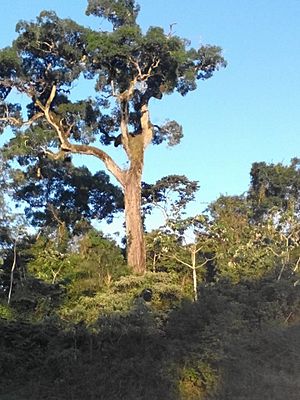Aspidosperma polyneuron facts for kids
Quick facts for kids Aspidosperma polyneuron |
|
|---|---|
 |
|
| Conservation status | |
| Scientific classification | |
| Genus: |
Aspidosperma
|
| Species: |
polyneuron
|
| Synonyms | |
|
|
The Peroba Rosa, officially known as Aspidosperma polyneuron, is a large tree famous for its strong wood. It is a native tree found in several South American countries. These include Brazil, Colombia, Peru, Argentina, and Paraguay.
This special tree is often found in the Atlantic Forest, a rich and diverse forest area. Besides its valuable wood, the Peroba Rosa is also helpful for beekeeping. Bees visit its flowers to collect nectar, which they turn into honey.
Contents
About the Peroba Rosa Tree
The Peroba Rosa is a type of timber tree. This means its wood is very useful for building and making things. It can grow very tall, reaching heights of up to 40 meters (about 130 feet). Its trunk can be quite wide, sometimes over a meter (3 feet) across.
The wood of the Peroba Rosa is known for being very strong and durable. It has a beautiful reddish-brown color. This makes it popular for many uses.
What Is Peroba Rosa Wood Used For?
Because of its strength and beauty, Peroba Rosa wood has been used for a long time. People use it to build houses, especially for strong beams and floors. It is also used to make furniture, doors, and window frames.
In the past, it was a very popular choice for railway sleepers. These are the wooden blocks that support train tracks. Its durability meant it could withstand heavy use and different weather conditions.
Where Does It Grow?
The Peroba Rosa tree naturally grows in South America. Its main home is in the Atlantic Forest. This forest stretches along the Atlantic coast of Brazil and into parts of Paraguay and Argentina. It also grows in other areas of Brazil, Colombia, and Peru.
The Atlantic Forest is a special place. It has many different types of plants and animals. The Peroba Rosa tree is an important part of this amazing ecosystem.
Why Is the Peroba Rosa Endangered?
Sadly, the Peroba Rosa is an endangered plant. This means there are not many of these trees left in the wild. Their numbers have dropped a lot over the years.
What Does "Endangered" Mean?
When a species is "endangered," it means it is at a very high risk of disappearing forever. If we don't protect these trees, they might become extinct. This would mean no more Peroba Rosa trees would exist anywhere on Earth.
Why Are They Disappearing?
The main reason the Peroba Rosa is endangered is deforestation. This is when forests are cut down. For many years, people cut down a lot of these trees for their valuable wood. They also cleared land for farming and cattle ranching.
Because the trees grow slowly, it takes a long time for new ones to replace the ones that are cut down. This makes it hard for their populations to recover.
Protecting the Peroba Rosa
Efforts are being made to protect the Peroba Rosa tree. Governments and environmental groups are working together. They are trying to save this important species.
- Protecting Forests: One way to help is by protecting the remaining Atlantic Forest. This means creating national parks and reserves where trees cannot be cut down.
- Sustainable Forestry: Another way is to promote sustainable forestry. This means cutting down trees in a way that allows the forest to regrow. It ensures there will be trees for the future.
- Planting New Trees: People are also planting new Peroba Rosa trees. This helps to increase their numbers. It also helps to restore parts of the forest that were lost.
- Raising Awareness: Teaching people about the importance of these trees helps too. When more people know about the problem, more can help find solutions.
By working together, we can help ensure the Peroba Rosa tree continues to thrive for future generations.
See also
 In Spanish: Aspidosperma polyneuron para niños
In Spanish: Aspidosperma polyneuron para niños



